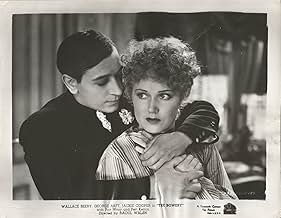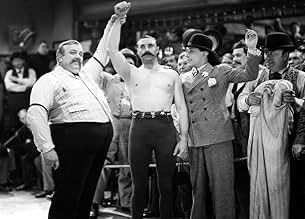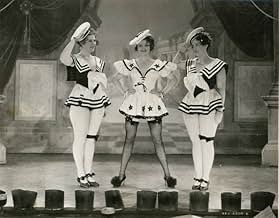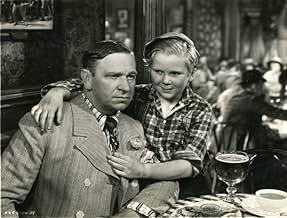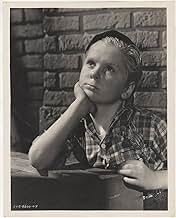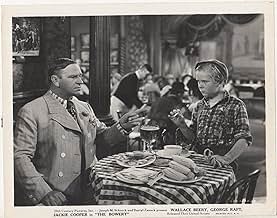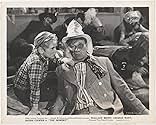AVALIAÇÃO DA IMDb
6,8/10
669
SUA AVALIAÇÃO
Na década de 1990, Nova York havia crescido, mas The Bowery havia-se tornado mais jovem e barulhento até se tornar conhecida como a "Milha mais viva da Face do Mundo".Na década de 1990, Nova York havia crescido, mas The Bowery havia-se tornado mais jovem e barulhento até se tornar conhecida como a "Milha mais viva da Face do Mundo".Na década de 1990, Nova York havia crescido, mas The Bowery havia-se tornado mais jovem e barulhento até se tornar conhecida como a "Milha mais viva da Face do Mundo".
- Direção
- Roteiristas
- Artistas
- Prêmios
- 3 vitórias no total
Bull Anderson
- Pug
- (não creditado)
Irving Bacon
- Hick
- (não creditado)
Lucille Ball
- Blonde
- (não creditado)
John Bleifer
- Mumbo the Mute
- (não creditado)
Phil Bloom
- Pug
- (não creditado)
James Burke
- Recruiting Sergeant
- (não creditado)
Marguerite Caverley
- Undetermined Secondary Role
- (não creditado)
Avaliações em destaque
Such are the title-song lyrics to this 1933 frolic, directed by Raoul Walsh to be modest in story but long on atmosphere. Made at 20th, it has something of an MGM cast: Wallace Beery and Jackie Cooper had been such a hit in "The Champ" two years earlier, the studio must have been anxious to reteam them. Cooper was a good little actor, but here, as.an unsympathetic little ruffian in the Lower East Side of the Gay '90s, he's just marking time, and Beery, whom practically everybody who ever worked with him appears to have loathed, tries and fails to be a charmer. The story's that of Steve Brodie and his alleged jump off the Brooklyn Bridge (it was also the basis for "Kelly," a one-night 1965 musical that was, up till then, the biggest money-loser in Broadway history); it's not much of a story, but it does allow for some lively set pieces, and George Raft, as Brodie, has a part that suits him well. There's also Fay Wray, who's warm and appealing, and Pert Kelton, expertly knocking out one of the sassy broads she did so well back then. Marred by phony-looking process shots and plot implausibilities and non-clear things (I'm still not sure, did they throw a dummy off the bridge or not?), and off-the-charts non-PC by today's standards, it's nevertheless rollicking, and you can be sure that under Walsh's watch you'll get hard-hitting fights, atmosphere galore, rude insult humor, and a setting where, like the song goes, they do strange things.
In his new 20th Century Pictures Corporation which was at the time releasing its product with United Artists, Darryl F. Zanuck almost had an MGM trifecta for his stars. Wallace Beery and Jackie Cooper came from MGM and Clark Gable almost did. But according to the biography of George Raft from James Parrish, Raft wanted very much to do this film and Zanuck accommodated him and got him from Paramount.
It was a wise move on Zanuck's part because Steve Brodie of the Bowery was a part Raft was born to play. And why not since Raft grew up in the Hell's Kitchen area of New York and knew the scene well.
As did Raoul Walsh who was born and raised in Rockaway Beach, New York and also knew the red light areas of the city well. The best thing that The Bowery has going for it was is the incredible detail in terms of creating the atmosphere of the Gay Nineties in one of New York's most colorful areas. In fact so much detail was presented that the film is rarely seen today for all the racial epithets it has. But that would be true of the era. Racial and ethnic stereotyping was the rule of the day. In fact Ragtime is also quite graphic in that, the difference being the point of view that film takes.
What The Bowery has in atmosphere with its sets, dialog with the idioms of the day, and costumes, it loses in accuracy. Set in 1897-98 before the Spanish American War it has the legendary Steve Brodie doing his jump off the Brooklyn Bridge at that time. In point of fact it was in 1886.
Raft as Brodie and Beery as Chuck Connors are a pair of friendly if caustic rivals of The Bowery area in lower Manhattan. The two are forever trying to top each other and that is given as the reason for Raft doing his famous dive off the Brooklyn Bridge and living to tell about it. Actually there is cause in real life to think Brodie never did the deed. And in fact some question is raised in Beery's mind which leads to the climax of The Bowery.
Jackie Cooper's well known antipathy to Beery has been documented, but in the Parrish book on Raft during a fight scene Beery got a little rougher than the script called for. Raft then responded with what is described as a roundhouse right into the family jewels. Beery reacted normally as one does when one is hit there.
If one values political correctness than do not see this film. But otherwise it is an all too accurate a look on a bygone era.
It was a wise move on Zanuck's part because Steve Brodie of the Bowery was a part Raft was born to play. And why not since Raft grew up in the Hell's Kitchen area of New York and knew the scene well.
As did Raoul Walsh who was born and raised in Rockaway Beach, New York and also knew the red light areas of the city well. The best thing that The Bowery has going for it was is the incredible detail in terms of creating the atmosphere of the Gay Nineties in one of New York's most colorful areas. In fact so much detail was presented that the film is rarely seen today for all the racial epithets it has. But that would be true of the era. Racial and ethnic stereotyping was the rule of the day. In fact Ragtime is also quite graphic in that, the difference being the point of view that film takes.
What The Bowery has in atmosphere with its sets, dialog with the idioms of the day, and costumes, it loses in accuracy. Set in 1897-98 before the Spanish American War it has the legendary Steve Brodie doing his jump off the Brooklyn Bridge at that time. In point of fact it was in 1886.
Raft as Brodie and Beery as Chuck Connors are a pair of friendly if caustic rivals of The Bowery area in lower Manhattan. The two are forever trying to top each other and that is given as the reason for Raft doing his famous dive off the Brooklyn Bridge and living to tell about it. Actually there is cause in real life to think Brodie never did the deed. And in fact some question is raised in Beery's mind which leads to the climax of The Bowery.
Jackie Cooper's well known antipathy to Beery has been documented, but in the Parrish book on Raft during a fight scene Beery got a little rougher than the script called for. Raft then responded with what is described as a roundhouse right into the family jewels. Beery reacted normally as one does when one is hit there.
If one values political correctness than do not see this film. But otherwise it is an all too accurate a look on a bygone era.
Culled from the real life exploits of Chuck Connors and Steve Brodie in 1890s New York, "The Bowery" is high energy and good natured.
But be warned: Casual racial epithets flow off the tongues of Wallace Beery and little Jackie Cooper. The very first shot might be startling. This is true to the time it was set and the time it was made. And it also speaks to the diversity of population in that neck of the woods. It certainly adds to the gritty flavor of the atmosphere.
Beery as Connors is the blustering thunder at the center of the action, a loud-mouth saloon keeper with his own fire brigade. And he has a soft spot for ornery orphan Cooper. Raft as Brodie is Connors' slicker, better looking rival in almost every endeavor. Brodie could never turn down a dare and loved attention, leading up to a jump off the Brooklyn Bridge (it is still debated whether he actually jumped or used a dummy).
Beery is as bombastic as ever with a put-on Irish-American accent. He is just the gruff sort of character to draw children, cats and ladies in distress. This is possibly the most boisterous character Raft ever played, and he even gets to throw in a little dancing (as well as a show of leg). And again he mistakes the leading lady (lovely Fay Wray) for a prostitute. Cooper is as tough as either of them, though he gets a chance to turn on the tears.
The highlight isn't the jump off the bridge but a no-holds-barred fistfight between Connors and Brodie that in closeup looks like a real brawl between the principals. It's sure someone bruised more than an ego.
But be warned: Casual racial epithets flow off the tongues of Wallace Beery and little Jackie Cooper. The very first shot might be startling. This is true to the time it was set and the time it was made. And it also speaks to the diversity of population in that neck of the woods. It certainly adds to the gritty flavor of the atmosphere.
Beery as Connors is the blustering thunder at the center of the action, a loud-mouth saloon keeper with his own fire brigade. And he has a soft spot for ornery orphan Cooper. Raft as Brodie is Connors' slicker, better looking rival in almost every endeavor. Brodie could never turn down a dare and loved attention, leading up to a jump off the Brooklyn Bridge (it is still debated whether he actually jumped or used a dummy).
Beery is as bombastic as ever with a put-on Irish-American accent. He is just the gruff sort of character to draw children, cats and ladies in distress. This is possibly the most boisterous character Raft ever played, and he even gets to throw in a little dancing (as well as a show of leg). And again he mistakes the leading lady (lovely Fay Wray) for a prostitute. Cooper is as tough as either of them, though he gets a chance to turn on the tears.
The highlight isn't the jump off the bridge but a no-holds-barred fistfight between Connors and Brodie that in closeup looks like a real brawl between the principals. It's sure someone bruised more than an ego.
I love this freekin movie! Walsh is a true master of the cinematic form, his film have been sometimes in my opinion, overlooked. But this film is a favourite of mine because it really gives you the feel of the time the film was set in.\
All the wonderful characters that existed, the lifestyle, the mode of dress, the way they spoke, OK they might be exaggerated, but it is good to know that there were occasion when two men tried to outdo each other with insane stunts.
I just felt it was apiece of history thats should be wathced by many people and appreciated because of that fact.
Can I get it somewhere on DVD? I have only seen it on TV. But for anyone wanting a slice of life movie about that period of time this is the perfect one.
All the wonderful characters that existed, the lifestyle, the mode of dress, the way they spoke, OK they might be exaggerated, but it is good to know that there were occasion when two men tried to outdo each other with insane stunts.
I just felt it was apiece of history thats should be wathced by many people and appreciated because of that fact.
Can I get it somewhere on DVD? I have only seen it on TV. But for anyone wanting a slice of life movie about that period of time this is the perfect one.
A favourite of mine,this movie tells of two feuding New York "characters", Steve Brodie(Raft) and "Chuck" Connors(Beery),who both strive to be the "Main Guy" in the Bowery in the late Nineteenth Century.
Brodie(1863-1901) and Connors(1852-1913),were real people,though this is a heavily fictionalized account of their antics(based on a play).Brodie's legendary(did he do it?- it's still a cause of argument!),jump from the Brooklyn bridge(1886),for which he became famous,is shown here as happening around the same time as the Spanish-American war(1898).Director Walsh clearly had a great affection for the period,so beautifully recreated here,and it includes a wild rumbustious ragtime number from saloon singer Trixie Odbray(a young Pert Kelton).Raft is at his slickest as Brodie,and Beery shows again what a clever actor he was,as tough, big hearted, and at times quite touching Connors.Pretty Fay Wray is the love interest both the boys are pursuing.
Full of life and energy,"The Bowery" moves at a fast pace(unlike many early "talkies").It is not an easy movie to find,but is well worth looking out for.
Brodie(1863-1901) and Connors(1852-1913),were real people,though this is a heavily fictionalized account of their antics(based on a play).Brodie's legendary(did he do it?- it's still a cause of argument!),jump from the Brooklyn bridge(1886),for which he became famous,is shown here as happening around the same time as the Spanish-American war(1898).Director Walsh clearly had a great affection for the period,so beautifully recreated here,and it includes a wild rumbustious ragtime number from saloon singer Trixie Odbray(a young Pert Kelton).Raft is at his slickest as Brodie,and Beery shows again what a clever actor he was,as tough, big hearted, and at times quite touching Connors.Pretty Fay Wray is the love interest both the boys are pursuing.
Full of life and energy,"The Bowery" moves at a fast pace(unlike many early "talkies").It is not an easy movie to find,but is well worth looking out for.
Você sabia?
- CuriosidadesGeorge Raft and Wallace Beery were at odds during filming. According to Raft, before the fistfight scene, Beery asked Raft to let him throw the first punch and then proceeded to sucker-punch Raft, knocking him out for several minutes. "When I came to I got up and called him everything I could think of," Raft said. They then fought for real, and the crew had to break it up.
- Erros de gravaçãoThe name of George Raft's character, "Steve Brodie," is misspelled "Brody" in the opening credits.
- Citações
Steve Brodie: Don't ever say I never give ya nothin'.
- Versões alternativasThe version shown on Fox Movie Channel runs seven seconds over 87 minutes. Apparently it is a reissue copy, the missing five minutes due to reediting to fit post code rules. Though it was made for Twentieth Century Films, a new start up film studio organized by Joe Schenck, Bill Goetz (L.B. Mayer's son-in-law) and ex-Warner Bros. production chief Darryl Zanuck, the FMC version is presented under the post merger logo of Twentieth Century Fox complete with fanfare and an end title crediting distribution to TCF. This year a full uncut version was shown at New York's Film Forum which clocked several minutes over ninety minutes.
- ConexõesEdited into Brooklyn Bridge (1981)
- Trilhas sonorasThe Bowery
(uncredited)
Music by Percy Gaunt
Lyrics by Charles Hale Hoyt
Sung by a chorus at the beginning
Played often in the score
Principais escolhas
Faça login para avaliar e ver a lista de recomendações personalizadas
- How long is The Bowery?Fornecido pela Alexa
Detalhes
Bilheteria
- Orçamento
- US$ 421.496 (estimativa)
- Tempo de duração
- 1 h 32 min(92 min)
- Cor
- Proporção
- 1.37 : 1
Contribua para esta página
Sugerir uma alteração ou adicionar conteúdo ausente

